Expert Tips on Value Bets in Horse Racing from Us

Expert Tips on Value Bets in Horse Racing from Us

Finding opportunities where the odds outweigh the risk can transform how enthusiasts approach wagering. This guide delivers actionable strategies to spot these moments, blending decades of expertise with real-world examples from iconic races. Whether analyzing legendary performances or modern-day underdogs, the focus remains on maximizing long-term returns.
Understanding market dynamics is key. Events like the Kentucky Derby showcase how factors like track conditions and competitor form influence prices. By comparing public perception with statistical probability, bettors uncover hidden edges. For instance, Secretariat’s historic Belmont Stakes win wasn’t just a triumph—it was a masterclass in odds evaluation.
This article breaks down proven methods to assess risk-reward ratios. Case studies, including Arazi’s Breeders’ Cup upset, reveal how unexpected outcomes create profit potential. Readers will learn to prioritize research over hunches, using data to identify mispriced opportunities.
Tailored for newcomers and veterans alike, these insights simplify complex concepts. From interpreting race-day variables to balancing short-term risks with sustainable gains, every tip aims to sharpen decision-making. The goal? Turn informed analysis into consistent results.
Understanding the Concept of Value in Horse Racing
Mastering the art of betting requires understanding when odds don’t match reality. This gap between perceived likelihood and true potential is where smart decisions thrive. Let’s explore how recognizing this difference shapes long-term success.

Defining Value in Betting
A wager holds value when the offered price exceeds the actual chance of winning. For example, Dialed In entered the 2011 Kentucky Derby with 8-1 odds despite strong workouts and a favorable post position. Those who recognized his underestimated potential secured higher returns when he finished fourth in a tight field.
Bookmakers often set lines based on public sentiment rather than statistical probability. Animal Kingdom’s 2011 Derby victory at 20-1 odds showcased how track bias and stamina projections can skew prices. His supporters capitalized on overlooked factors like pedigree and jockey strategy.
Why Value Matters on Race Day
Even slight discrepancies in odds compound over time. Imagine consistently backing runners with a 5% edge—this subtle advantage transforms into measurable profit across hundreds of races. High-stakes events magnify these opportunities, as crowds often overreact to recent performances or weather changes.
Research separates guesswork from strategy. Analyzing past results, trainer patterns, and surface preferences helps pinpoint mispriced contenders. This disciplined approach turns chaotic race days into calculated ventures.
Expert Strategies to Identify value bets in horse racing
Spotting undervalued opportunities demands a blend of sharp analysis and market awareness. Professionals focus on patterns others miss, turning raw data into actionable insights. Here’s how they do it.

Decoding Recent Performances and Trends
Reviewing a runner’s last five races reveals consistency gaps. For instance, a contender finishing strong in muddy conditions might struggle on dry tracks—a detail casual bettors overlook. Workout times also matter. A recent bullet drill (fastest training session) often signals readiness, like Gun Runner’s dominant 2017 Breeders’ Cup prep.
Market sentiment shifts with news. When rain softens a turf course, odds for mud-loving athletes drop late. Savvy observers track these movements, pouncing before prices adjust.
Uncovering Mispriced Contenders
Bookmakers sometimes undervalue partnerships. Take jockey Irad Ortiz Jr. and trainer Chad Brown—their 24% win rate together in 2023 created hidden edges. If their entry drifts in odds due to a single poor outing, sharp players recognize the long-term upside.
Comparing odds across platforms exposes discrepancies. A 10-1 shot on one site might be 8-1 elsewhere. Tools like Oddschecker simplify this research, highlighting arbitrage chances.
By merging form studies, surface preferences, and partnership stats, experts build portfolios of overlooked contenders. This methodical approach turns fleeting chances into steady gains.
Mastering the Math Behind Winning Probabilities
The backbone of consistent success lies in mathematical precision. By quantifying chances and margins, bettors turn chaotic predictions into structured opportunities. Let’s explore how numbers reveal hidden edges.

Calculating True Odds vs. Market Odds
Implied probability shows what the market believes. Convert decimal odds by dividing 100 by the price. A runner priced at 4.0 has a 25% implied chance (100/4). If your analysis suggests a 30% true probability, that 5% gap becomes profit potential over time.
Take a recent example: A contender with 6.0 odds implies a 16.7% win likelihood. Historical data showing three wins in 15 similar races (20% actual rate) signals undervaluation. This mismatch creates actionable value.
Interpreting Market Percentages
Bookmakers balance their books by adjusting prices. Add every runner’s implied probability—if the total exceeds 100%, the difference is their margin. A 115% market means a 15% “overround” favoring the house.
Sharp players focus on races where this percentage dips below 110%, indicating softer pricing. For instance, a seven-athlete field totaling 108% leaves room for savvy bets. Track these totals across platforms to spot inefficiencies.
Small math-based adjustments compound. A 2% edge per wager grows exponentially across hundreds of events. Pair this discipline with real-time data on track surfaces and weather shifts to refine calculations.
Advanced Techniques and Insider Insights
Elevating your strategy requires tools beyond basic analysis. Seasoned bettors combine niche methods with disciplined execution to unlock hidden opportunities. Let’s explore three approaches that reshape risk management.
Implementing Dutching and Arbitrage Methods
Dutching spreads risk across multiple contenders. If two athletes show 25% win probability each at 5-1 odds, backing both guarantees profit if either succeeds. This works best in small fields where public opinion overlooks viable candidates.
Arbitrage exploits price gaps between platforms. A runner priced at 9-1 on one site might be 7-1 elsewhere. Quick comparisons using odds aggregators let sharp players lock in margins before markets adjust.
Leveraging Each-Way and Alternative Bets
Each-way wagers shine when a strong contender faces elite competition. If a 10-1 shot frequently finishes top three, this bet pays even without victory. Recent results show these strategies outperform straight win bets in competitive events.
Alternative markets like “top three finish” or “matchups” offer better percentages when favorites dominate. A third-place finisher at 20-1 often delivers higher returns than the winning favorite at even odds.
Managing Bankroll and Avoiding Common Pitfalls
Allocate no more than 2% per wager to survive losing streaks. Professionals track every bet, adjusting stakes based on confidence levels. Emotional decisions—like chasing losses after a bad day—crush long-term growth.
Insider tip: Use separate accounts for different strategies. This prevents overexposure and clarifies what’s working. Discipline turns volatile outcomes into steady progress.
Conclusion
Turning insights into consistent results requires merging sharp analysis with disciplined execution. This guide outlined how comparing statistical probabilities to public perceptions reveals hidden opportunities. By focusing on track conditions, partnership success rates, and market shifts, bettors position themselves ahead of casual observers.
Long-term profitability stems from balancing math with real-world variables. Calculating true odds against posted prices helps spot misjudged contenders. Pairing this with research on surface preferences and workout patterns builds a robust strategy.
No approach guarantees daily wins, but methodical habits stack odds in your favor. Allocate stakes wisely, track outcomes, and refine techniques using tools like odds comparison platforms. Progress comes through persistent learning—every race offers fresh data to test theories.
Ready to elevate your game? Start applying these frameworks to uncover overlooked edges. With patience and practice, transforming raw potential into measurable gains becomes second nature.
FAQ
How does “value” differ from simply picking winners?
Value focuses on identifying discrepancies between a horse’s true chance of winning and the odds offered. It’s not just about selecting the fastest runner but finding opportunities where the payout outweighs the risk based on probability.
Can beginners apply these strategies effectively?
Absolutely. While experience helps, even newcomers can learn to assess factors like recent form, track surfaces, and jockey-trainer partnerships. Starting with basic analysis and tracking results builds confidence over time.
Why do market percentages matter when evaluating odds?
Market percentages reveal how the public perceives each runner’s chances. If the total exceeds 100%, it indicates overround (bookmaker profit margin). Savvy bettors look for underrated contenders where public sentiment skews the math.
How does Dutching improve long-term profitability?
Dutching spreads risk by backing multiple horses in a race while ensuring consistent returns. This method minimizes losses during unpredictable events and capitalizes on races with several viable contenders.
Are each-way bets reliable for consistent gains?
Each-way bets work best in specific scenarios, like large fields or races with clear favorites. They provide a safety net if a strong runner places, but relying solely on them without assessing value can erode profits.
What separates expert bankroll management from amateur approaches?
Professionals allocate fixed percentages of their funds per wager and avoid chasing losses. They prioritize discipline over emotions, ensuring short-term setbacks don’t derail their long-term strategy.
How do track conditions influence hidden potential?
Some runners excel on wet surfaces or specific distances. Reviewing past performances in similar environments helps uncover overlooked contenders poised to outperform their odds.





